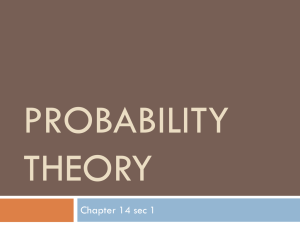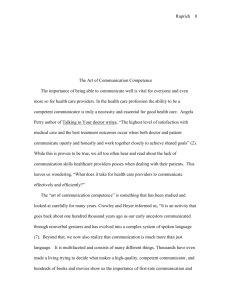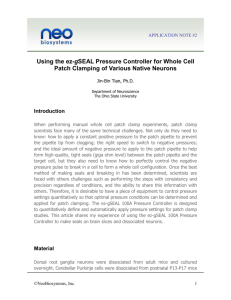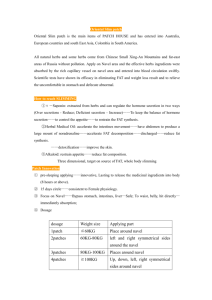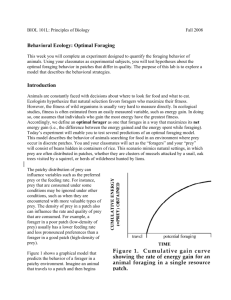JANE_1670_sm_DuchesneFortinCourbin
advertisement
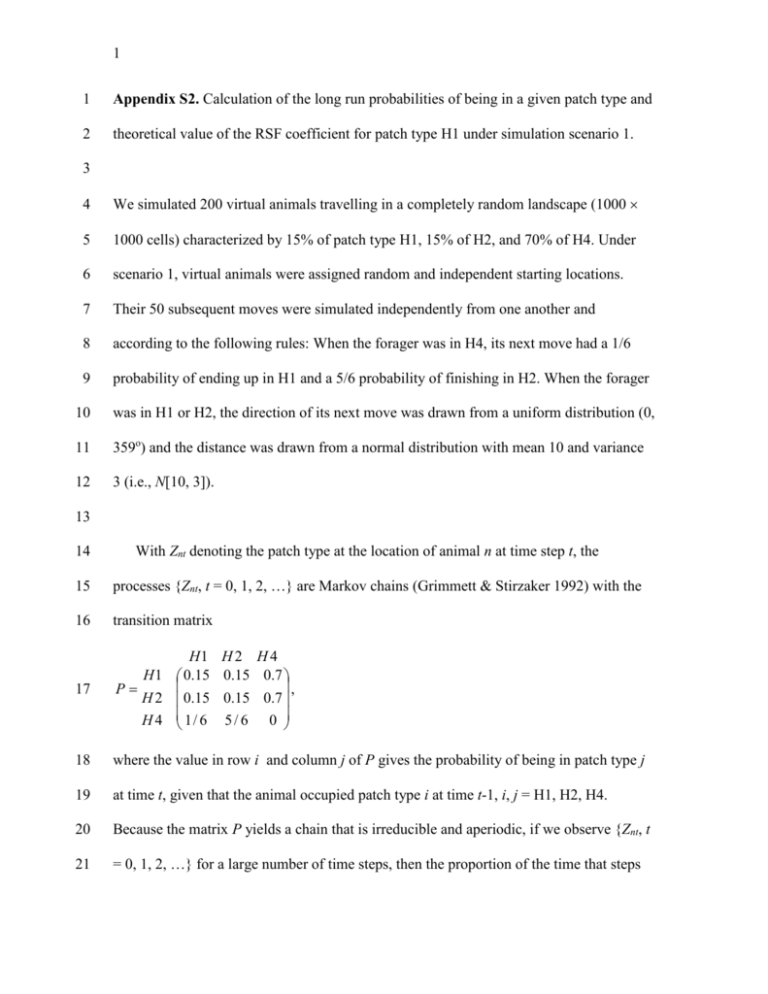
1
1
Appendix S2. Calculation of the long run probabilities of being in a given patch type and
2
theoretical value of the RSF coefficient for patch type H1 under simulation scenario 1.
3
4
We simulated 200 virtual animals travelling in a completely random landscape (1000
5
1000 cells) characterized by 15% of patch type H1, 15% of H2, and 70% of H4. Under
6
scenario 1, virtual animals were assigned random and independent starting locations.
7
Their 50 subsequent moves were simulated independently from one another and
8
according to the following rules: When the forager was in H4, its next move had a 1/6
9
probability of ending up in H1 and a 5/6 probability of finishing in H2. When the forager
10
was in H1 or H2, the direction of its next move was drawn from a uniform distribution (0,
11
359o) and the distance was drawn from a normal distribution with mean 10 and variance
12
3 (i.e., N[10, 3]).
13
14
With Znt denoting the patch type at the location of animal n at time step t, the
15
processes {Znt, t = 0, 1, 2, …} are Markov chains (Grimmett & Stirzaker 1992) with the
16
transition matrix
17
H1
H 1 0.15
P
H 2 0.15
H 4 1 / 6
18
where the value in row i and column j of P gives the probability of being in patch type j
19
at time t, given that the animal occupied patch type i at time t-1, i, j = H1, H2, H4.
20
Because the matrix P yields a chain that is irreducible and aperiodic, if we observe {Znt, t
21
= 0, 1, 2, …} for a large number of time steps, then the proportion of the time that steps
H2 H4
0.15 0.7
,
0.15 0.7
5 / 6 0
2
1
are spent in each patch type converges towards the long run (steady state) probabilities π
2
= (πH1, πH2, πH4) that solve πP = π. For the matrix P given above, we obtain π = (0.157,
3
0.431, 0.412).
4
5
Now the theoretical value of the RSF coefficient for H1 under scenario 1 corresponds
6
to the log of the following odds ratio: odds that a location is visited when it is of habitat
7
type H1 over the odds that a location is visited when it is of habitat type H2 (baseline
8
habitat type). If Y = 1 denotes the event that a given location chosen at random in the
9
landscape is visited and Y = 0 is the event that it is not visited, while X = 1 denotes that a
10
given location chosen at random is associated with a patch of type H1 and X = 0 with a
11
patch of type H2, then the theoretical value of the regression coefficient is given by
12
.
H 1 ln
Pr[Y 1 | X 0] / Pr[Y 0 | X 0]
13
Assuming that the probabilities π1 (long run probability that the animal is in H1) and π2
14
(long run probability that the animal is in H2) derived from P above are good
15
approximations of Pr[X=1|Y=1] (probability that a location is in H1 given that it is
16
visited) and Pr[X=0|Y=1] (probability that a location is in H2 given that it is visited),
17
respectively, then we can use Bayes’ rule to compute all four probabilities involved in
18
βH1:
19
Pr[Y 1 | X 1]
20
where Pr[Y =1]=10,000/1,000,000 (number of visited locations / total number of
21
locations), Pr[Y=0]=1-Pr[Y=1] and Pr[X=1|Y=0]=0.15 (locations chosen at random in the
22
landscape are of type H1 with probability 15%). Note that the value of the probability
Pr[Y 1 | X 1] / Pr[Y 0 | X 1]
eqn S1
Pr[ X 1 | Y 1] Pr[Y 1]
,
Pr[ X 1 | Y 1] Pr[Y 1] Pr[ X 1 | Y 0]P[Y 0]
3
1
Pr[Y =1] is completely irrelevant because it cancels out in the odds ratio of interest.
2
Repeating a similar argument for all four probabilities implied in equation S1 yields
3
H 1 ln
0.0947 / 0.905
1.01 .
0.223 / 0.777
4
5
The long run probabilities π = (0.157, 0.431, 0.412) provide a slight underestimation
6
of the ratio of the odds of being in H1 over the odds of being in H2, because the virtual
7
animals were distributed randomly across the landscape at time 0, i.e., with probabilities
8
of starting in H1, H2, and H4 of 0.15, 0.15 and 0.70, respectively. As a result, it takes a
9
few steps before the simulations sample from the steady state distribution (0.157, 0.431,
10
0.412) and therefore the value of -1.01 is a slight underestimation of the true value of the
11
regression parameter. The calculations in this appendix would have yielded the true value
12
of the regression parameter if the virtual foragers had begun (time 0) their path in the
13
various patch types according to the steady state distribution π = (0.157, 0.431, 0.412).
14
15
Reference
16
17
18
Grimmett, G.R. & Stirzaker, D.R. (1992) Probability and random processes, 2nd edn.
Oxford University Press, New York.

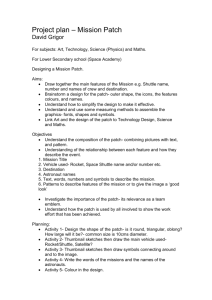




![Pumpkin Patch - L2 exam summary questions[1]](http://s3.studylib.net/store/data/006891404_1-eaba8a01ed43ce8c58f5173adc5f257b-300x300.png)
